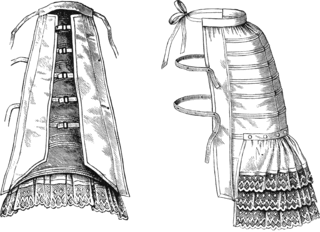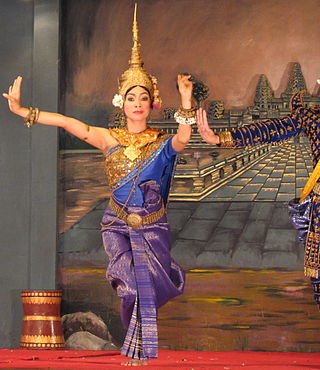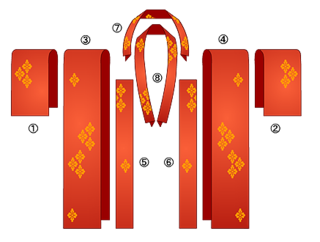Related Research Articles

Serge is a type of twill fabric that has diagonal lines or ridges on both sides, made with a two-up, two-down weave. The worsted variety is used in making military uniforms, suits, great coats and trench coats. Its counterpart, silk serge, is used for linings. French serge is a softer, finer variety. The word is also used for a high-quality woven woolen fabric.

Gabardine is a durable twill worsted wool, a tightly woven fabric originally waterproof and used to make suits, overcoats, trousers, uniforms, windbreakers, outerwear and other garments.

Dyeing is the application of dyes or pigments on textile materials such as fibers, yarns, and fabrics with the goal of achieving color with desired color fastness. Dyeing is normally done in a special solution containing dyes and particular chemical material. Dye molecules are fixed to the fiber by absorption, diffusion, or bonding with temperature and time being key controlling factors. The bond between dye molecule and fiber may be strong or weak, depending on the dye used. Dyeing and printing are different applications; in printing, color is applied to a localized area with desired patterns. In dyeing, it is applied to the entire textile.

A pea coat is an outer coat, generally of a navy-coloured heavy wool, originally worn by sailors of European and later American navies. Pea coats are characterized by short length, broad lapels, double-breasted fronts, often large wooden, metal or plastic buttons, three or four in two rows, and vertical or slash pockets. References to the pea jacket appear in American newspapers at least as early as the 1720s, and modern renditions still maintain the original design and composition.

Double cloth or double weave is a kind of woven textile in which two or more sets of warps and one or more sets of weft or filling yarns are interconnected to form a two-layered cloth. The movement of threads between the layers allows complex patterns and surface textures to be created.

Harris Tweed, is a tweed cloth that is handwoven by islanders at their homes in the Outer Hebrides of Scotland, finished in the Outer Hebrides, and made from pure virgin wool dyed and spun in the Outer Hebrides. This definition, quality standards and protection of the Harris Tweed name are enshrined in the Harris Tweed Act 1993.

Dimity was a collective term for figured cloths of harness loom decorated with designs and patterns. It was a strong cotton cloth with various stripes and illustrations. It was only bleached or washed after loom less often dyed after looming, unlike fustian, usually dyed.

Tweed is a rough, woollen fabric, of a soft, open, flexible texture, resembling cheviot or homespun, but more closely woven. It is usually woven with a plain weave, twill or herringbone structure. Colour effects in the yarn may be obtained by mixing dyed wool before it is spun.

Red coat, also referred to as redcoat or scarlet tunic, was a military garment which was widely used by the infantry units of the British military, including the British Army and Royal Marines, from the 16th to 19th centuries. The garment was also widely used by the British Colonial Auxiliary Forces and the British Indian Army during the 18th and 19th centuries. Though by the 20th centuries the red coat was abandoned for practical duties in favour of khaki by all British and Commonwealth military units, it continues to be used for ceremonial full dress and mess dress uniforms.

Broadcloth is a dense, plain woven cloth, historically made of wool. The defining characteristic of broadcloth is not its finished width but the fact that it was woven much wider and then heavily milled in order to shrink it to the required width. The effect of the milling process is to draw the yarns much closer together than could be achieved in the loom and allow the individual fibres of the wool to bind together in a felting process, which results in a dense, blind face cloth with a stiff drape which is highly weather-resistant, hard wearing and capable of taking a cut edge without the need for being hemmed.
The manufacture of textiles is one of the oldest of human technologies. To make textiles, the first requirement is a source of fiber from which a yarn can be made, primarily by spinning. The yarn is processed by knitting or weaving, which turns yarn into cloth. The machine used for weaving is the loom. For decoration, the process of colouring yarn or the finished material is dyeing. For more information of the various steps, see textile manufacturing.

A sampot, a long, rectangular cloth worn around the lower body, is a traditional dress in Cambodia. It can be draped and folded in several different ways. The traditional dress is similar to the dhoti of Southern Asia. It is also worn in the neighboring countries of Laos and Thailand where it is known as pha nung.

Barathea, sometimes spelled barrathea, is a soft fabric, with a broken twill weft rib, giving a surface that is lightly pebbled or ribbed, with the effect of a twill running both left and right. Original developed as a cloth for mourning clothes in the 1840s, it took several decades to become popular for other purposes, due to its association with bereavement.

Herringbone, also called broken twill weave, describes a distinctive V-shaped weaving pattern usually found in twill fabric. It is distinguished from a plain chevron by the break at reversal, which makes it resemble a broken zigzag. The pattern is called herringbone because it resembles the skeleton of a herring fish. Herringbone-patterned fabric is usually wool, and is one of the most popular cloths used for suits and outerwear. Tweed cloth is often woven with a herringbone pattern.

Oilcloth, also known as enameled cloth or American cloth, is close-woven cotton duck or linen cloth with a coating of boiled linseed oil to make it waterproof.
Ardfinnan Woollen Mills was a former wool mill, trading under messrs Mulcahy-Redmond and Co. Ltd. and located in the Suir Valley at the village of Ardfinnan, County Tipperary, Ireland. Founded in 1869, it manufactured woollen and worsted cloth, specialising in tweed and suitings for the tailoring trade. It briefly produced a unique weatherproof cloth, while later in its history turning to off-the-peg suits it became noted as the only firm in the Republic of Ireland completing all processes of clothing manufacture. A leading industry in Irish textiles, it closed in 1973 with the loss of over 100 employees.

Crash is a coarse fabric with a rough, irregular surface, made from thick, uneven yarns. Crash fabric is coarse linen based rugged material made from both dyed and raw yarns. The yarns used are often grey or white in color. Crash fabrics are indistinct woven. Linen is generally used for the warp, while blends of linen and jute, cotton, and wool, etc. were used for the filling. The weave structure may vary from plain, twill to fancy. Crash fabric was very thick, strong, rough and because of linen's characteristics it is absorbent also.
Silesia was a thin twilled woven cloth made of linen or cotton. The term denoted a wide range of fabric grades from greige goods to dyed and finished cloth. Silesia was used for various linens, for lining clothes, and in window blinds. Cotton Silesia was calendered to obtain a gloss finish.

A tanmono is a bolt of traditional Japanese narrow-loomed cloth. It is used to make traditional Japanese clothes, textile room dividers, sails, and other traditional cloth items.
Salu is a type of twill cloth, woven from cotton and dyed red, originally made in India. Prior to the introduction of modern industrial techniques, it was produced exclusively hand spun (khaddar) yarns with locally-available dyes. Salu is one of seven cotton cloths explicitly mentioned in the 16th century Mughal record Ain-i-Akbari, together with khasa, tansukh, doriya, bafta, dupatta, and panchtoliya.
References
- ↑ J.H. Cutler, tailors, Sydney, Australia, "Bespoke Tailoring Glossary of Terms"
- ↑ "Fabric Glossary - Cloak & Dagger Creations". Cloakmaker.com. Retrieved 2016-01-18.
- ↑ "Donkey Jackets. £54. Quality Donkey Jacket, Work Coats". Bennevisclothing.com. Retrieved 2016-01-18.
- ↑ Chemical age, Volume 21. Morgan-Grampian. 1929. Retrieved 26 January 2019.
with Mr. A. Wilkinson, who is still working for the firm - William Lupton and Co - at the age of 71, in dyeing for Windsor Castle curtains of Leeds-made Melton cloth. The curtains were dyed a dark ruby 30 years ago to the order of Queen Victoria, and are still unfaded
- ↑ "War names in new Leeds streets". Yorkshire Evening Post, Yorkshire, England - 30 March, 1920. Retrieved 26 January 2019.
The Windsor Castle curtains which Mr. Wilkinson dyed years ago are Melton cloth and were manufactured by Messrs. William Lupton and Co., another old-established firm, and it is an interesting fact that the order from 1888 was a repetition of an order executed by..
- ↑ Fairchild's dictionary of textiles. Internet Archive. New York, Fairchild Publications. 1959. p. 8.
{{cite book}}: CS1 maint: others (link)


